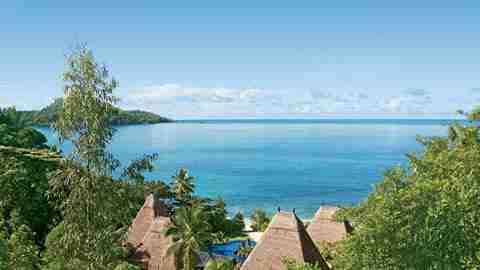December 14,2022
Maia Luxury Resort Spa
by David Stewart
View Slideshow

The site came first," says architect Lek Bun-nag. It always does, of course. But in the case of Maia Luxury Resort Spa, a sensitively designed, environmentally conscious resort in the African island nation known as the Republic of the Seychelles, the lush tropical surroundings dictated every aspect of the design.
It's easy to see why. Here, 1,000 miles due east of Kenya, the ocean tends toward lapis lazuli, that rich azure shade the Renaissance painters favored. The sky follows suit. Across the water, some of the 115 islands—most uninhabited—that make up the Seychellian archipelago loom intriguingly. How could such magnificent surroundings not play a central role?
"We wanted to step very gently on the surface of the earth," landscape architect Bill Bensley says. "It would have been easy to take elephant steps that would have smothered the beauty of the place. To build appropriately and delicately on the site was clearly the right thing to do."
Bensley, an American, and Bunnag—who describes himself as "very Thai"—met as graduate students at Harvard. Now each has a practice in Bangkok: Bensley Design Studios offers architecture, interior design and landscape architecture services; Bunnag Architects specializes in resort design. "My work is deeply connected to the cultural heritage of each place," Bunnag says. "If I were to build in India, it should look and feel unmistakably Indian."
Imparting a Seychellian look, though, turned out to be a challenge, since, as Bensley explains, "they never developed much of an architectural style." Only settled in the late 18th century and without an indigenous population, the Seychelles were first colonized by the French, then by the British. Although there are some French colonial buildings (mainly on Mahé, the island on which the resort is located), the rest is something of a pastiche.
Fittingly, Bunnag, working in partnership with RSL Architects (part of DSA Architects International Group), looked to mainland Africa for inspiration. He conceived the resort as a timeless native village, with clusters of hutlike structures with roofs—of "the local thatch," he says—in a variety of shapes. "Using a pavilion style instead of a block type causes less damage to the site," the architect comments.
Guests enter the resort via an open-sided "greeting pavilion," set among palms and other native plantings. Beyond it, there's an appealing bar with a fringed conical roof and columns clad in woven copper strips; other pavilions contain a restaurant, a shop and a spa. While there is a scattering of guest villas on the beach, most are perched on the hill above and reached by one of the buggies that circulate up and down.
Seen from above, the ocean reveals itself to be action-packed, with giant tortoises and passing dolphin pods and schools of gaudily colored fish. "It's a Las Vegas floor show!" Bensley says with a laugh. Maia itself can seem equally phantasmagoric. The deep blue of its contoured swimming pool out-azures the ocean; and at night, fire roars up out of five hand-carved totems at its side.
Although most of the resort's 131 pavilions are functional, of course, at least one—conical-roofed, with indigenous, slatted furnishings—is exuberantly not. "It serves no purpose," Bensley says. "It's just a pass-through space or a place to wait for a buggy if it's raining." Yet, in its distinct Africanness and the preponderance of wood—"the warmest element," Bensley points out—it neatly propounds Maia's design lexicon.
There are 30 villas—bungalows, actually—reached through individual gated gardens. Each is made up of four separate pavilions: a bedroom, a living area, an outdoor tub and a bath. All have at least one pool—most have two—and expansive terraces that seem to be suspended above the earth.
Furnishings are deliberately scant. "Our intuition was to do architectural interiors rather than interior design," Bunnag explains. "I wanted to have as little furniture as possible." From the outset, Bensley, who acted as both landscape architect and interior designer on this project, "wanted to do something really strong, with textures like African artifacts," he says. The fact that he knew little about Africa wasn't an impediment. He's an extraordinarily quick study—"an image collector," Bunnag calls him, "with very precise, scanning eyes." Repeated trips through Africa quickly brought him up to speed.
Bensley mined these nations' rich folk crafts in his interiors, most dramatically in the resort's restaurant, where an expansive chandelier, inspired by an African bracelet, forms a downward counterpoint to the pavilion's intricate vaulted ceiling. The distinctive, outsize metallic ornaments—made in Southeast Asia, like so many elements here—on the surrounding walls are also based on jewelry.
The restaurant's warm, tawny color gives way, in the guest rooms, to a more austere palette: browns and beiges that might have sprung from the African earth. Bensley designed every particle of the rooms, down to the sinuously shaped door handles, inspired by the resplendent local marine life.
Each guest room sets a scene. In one, majestic white lamps, tall and spherical as totem poles, rise up on either side of the headboard, their abrupt verticality softened by artistically draped swaths of mosquito netting. On the adjoining wall, there are rows of onyx bowls set in copper niches; the vessels are filled with hibiscus and other tropical flowers during the day, flickering tea candles at night.
Such inventive details arose almost organically, Bensley says. "If you can get the first step right, and I think that's what Lek did so beautifully, then everything else can fall into place. After that, all the other details are easy." This circles back to the design's underlying philosophy, which Bensley sums up as "respect Mother Nature first. Here, we very gently tiptoed around the site. If you can do that, it's win-win."






